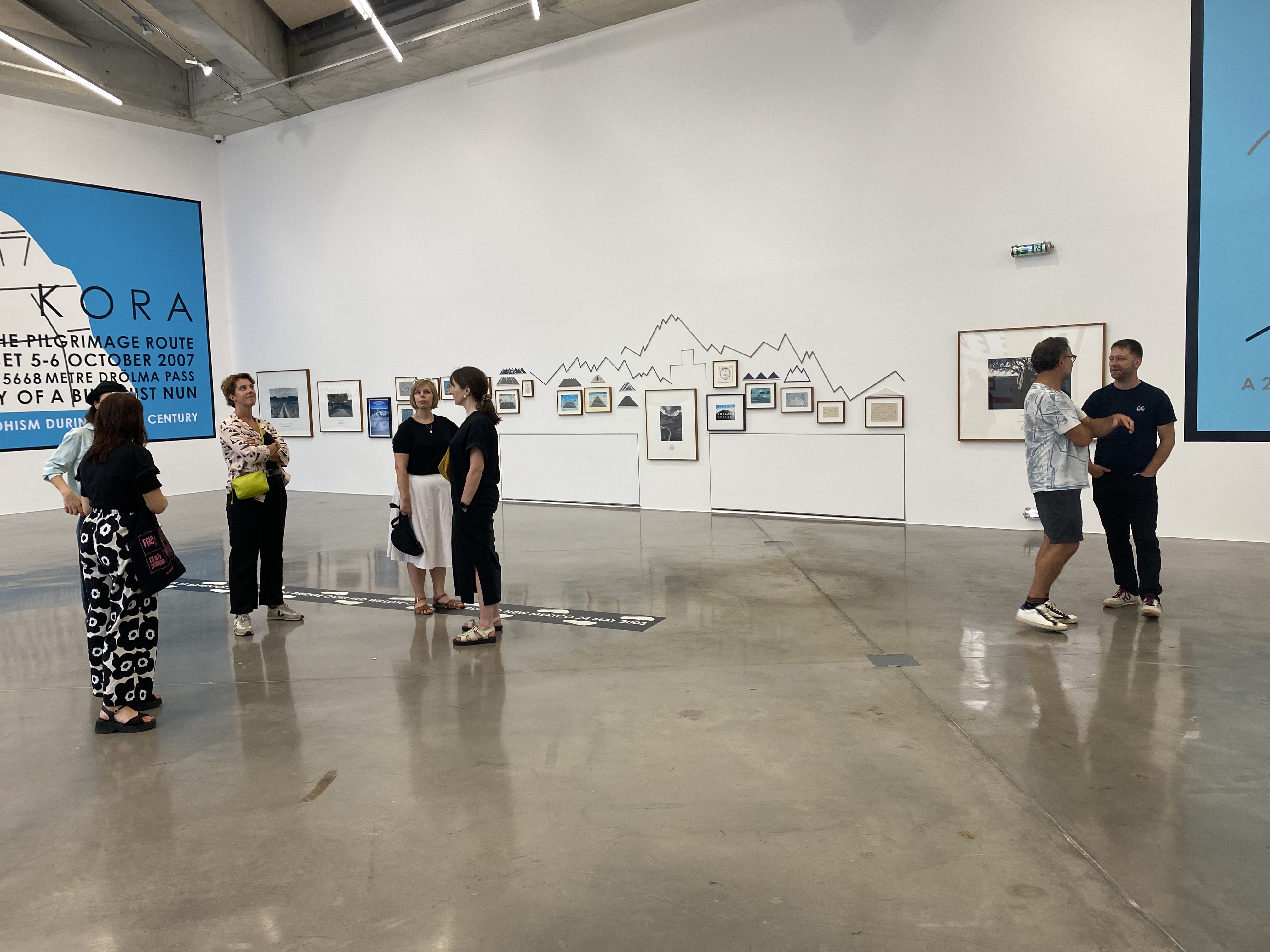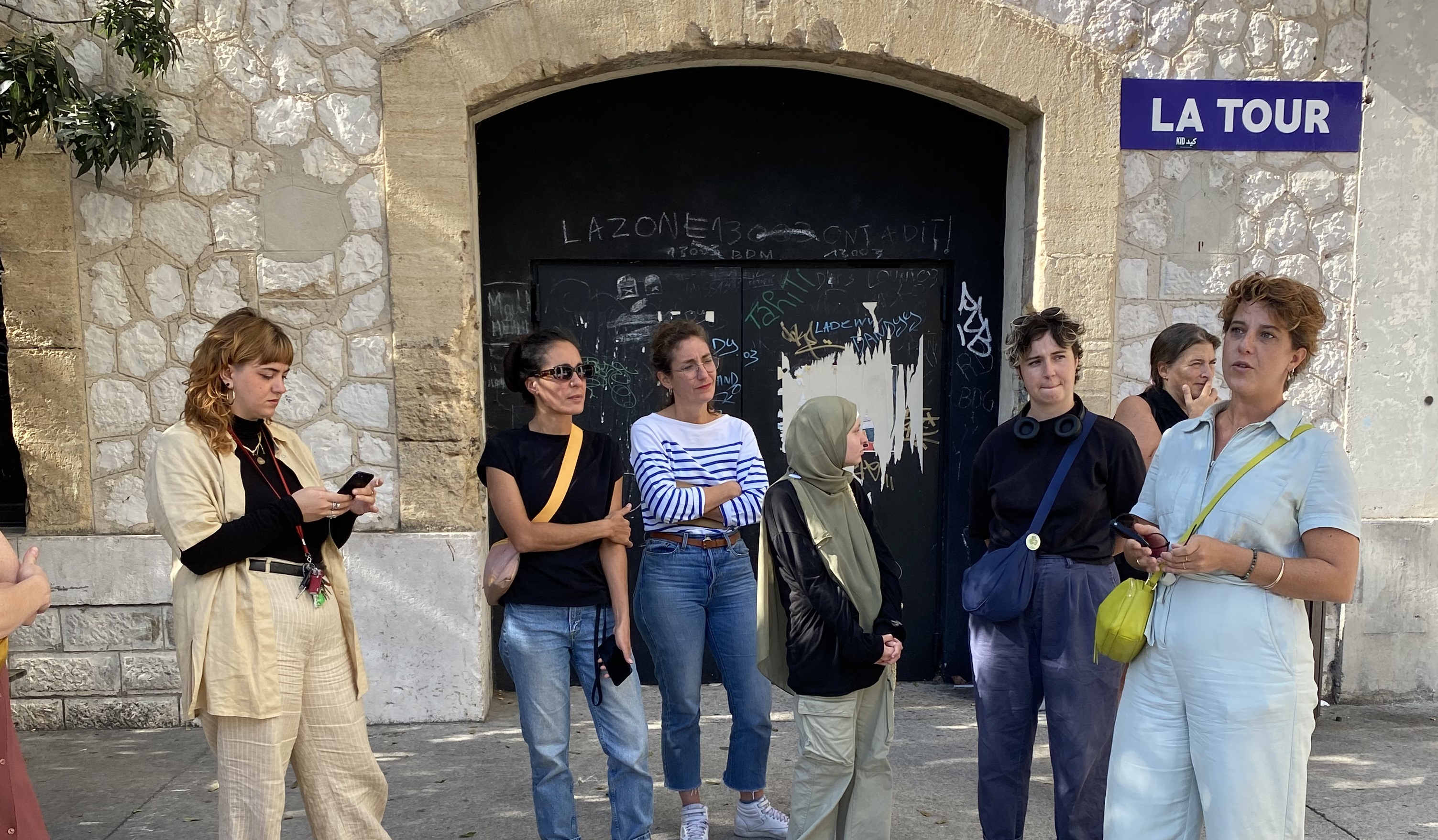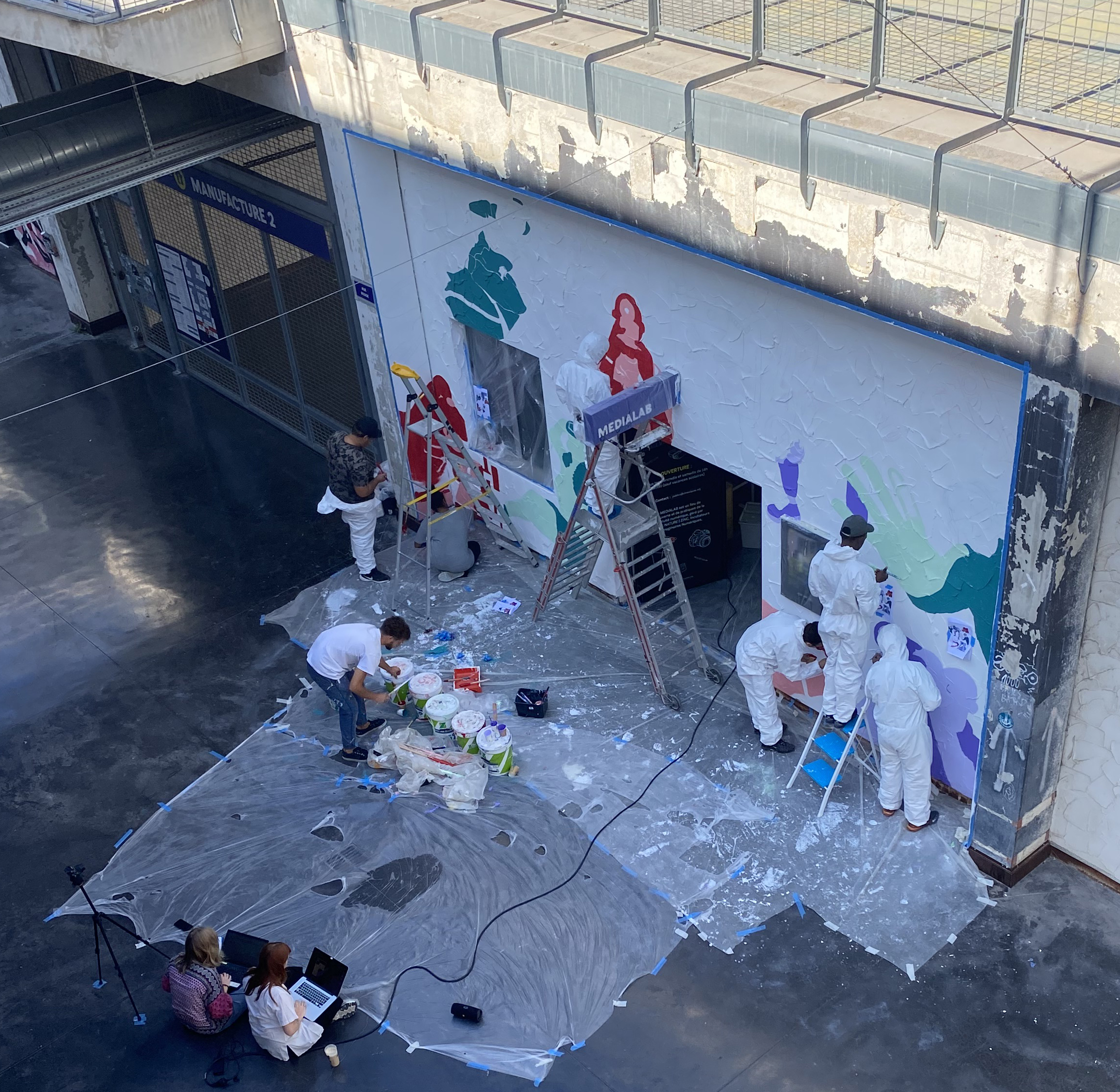The Value│Power symposium emerged from T-Lab 1 conversations concerning the role of arts and culture within the context of temporary urbanism. Recent UK research suggests that temporary art and design interventions, or pop-ups, can lead to unintended consequences, such as accelerated gentrification and a rise in urban precarity (Ferreri 2021; Harris 2020). The objective of the symposium was to discern lasting values emanating from art and design practices. Although the generation of cultural and social value through these types of activities is historically established and tacit in many practitioner’s approaches, effectively conveying this value remains challenging. The event hosted at La Friche served as a platform to share insights on the capacity of initiatives in the built environment to cultivate social value. It was split into two sections: the initial, 'Value,' investigated the subject of understanding and metrics, while the subsequent, 'Power,' probed the potential ramifications of these values.
Key Learnings:
- Role of Temporary Urbanism in Arts and Culture: Meanwhile interventions in urban contexts can lead to unexpected consequences, as such it is worth reflecting on the ethics and intentions of these kinds of practice.
- The Challenge of Conveying Value: While art and design practitioners have a rich history of generating cultural and social value, effectively communicating this value remains an ongoing challenge.
- Policy versus Reality: There is a disparity between policy understanding and actual definitions of cultural and social value. This misalignment often results in a conflation of cultural value with socio-economic outcomes in policy making.
- The Importance of Context in Evaluation: Evaluation methods that focus solely on economic metrics overlook the broader, context-specific impacts and values of cultural projects. Context-specific indicators and stakeholder involvement can lead to richer insights.
- Community Centres as Social Value Anchors: In France, community centres play a crucial role in fostering social connections and enhancing social value across various demographics.
- Emerging Metrics and Traditional Methodologies: There's an evident tension between conventional practices and evolving metrics of social value in the professional sphere. The UK's emphasis on demonstrating social value in public projects and the financial sector's focus on ESG considerations exemplify this shift.
- Community-Driven Development: Camden's approach underscores the importance of community-driven development, emphasising long-term improvement and a commitment to its residents.
- The Fluid Nature of Social Value: Designing public spaces is not just about physical components but about fostering platforms for community interaction, participation, and identity. The evolving needs of communities require a balance with design intentions.
- The Politics of Social Impact Evaluation: Social impact evaluations are intrinsically political, and their rise is intertwined with the growth of social investment and impact investing. However, the increasing institutionalisation of evaluation methods brings inherent risks.
Recommendations:
- Reimagining Cultural Value Systems: There is a need to adopt an interconnected understanding of cultural and social value, moving beyond siloed growth models. Cultural value could be leveraged as a tool to reimagine systems and boost social well-being.
- Inclusive Evaluation Method: Embrace alternative evaluation methods that move beyond traditional economic metrics to offer a broader understanding of the value and impact of cultural projects.
- Stakeholder Collaboration: Engage stakeholders and local communities actively in policy dialogues, project evaluations, and design processes to ensure that initiatives resonate with their needs and aspirations.
- Adopting Geospatial Tools for Place Analysis: Utilise geospatial tools for place analysis to bridge the 'language barrier' between traditional methodologies and new social value metrics.
- Balancing Accountability with Learning and Advocacy: While accountability in evaluations is crucial, it's equally vital to use evaluations for quality improvement, internal learning, and advocacy.
- Guarding Against Institutionalisation Risks: Be wary of the risks associated with the increasing institutionalisation of evaluation methods, such as tendencies towards isomorphism and instrumentalization. There's a need to maintain authenticity and genuine value in evaluations.
Keynote: UK (and US) Perspectives on Cultural Value
Patrycja Kaszynska
Patrycja discussed UK and US perspectives on cultural value, highlighting discrepancies between policy understanding and actual definitions of cultural and social value. The presentation explored the conflation of cultural value with social and economic outcomes in policy-making, leading to distortions in how these values are understood and measured. She critiqued the economic methods used to evaluate cultural value, emphasising their inherent flaws and misalignment with public sentiment. Drawing upon the US concept of creative place-making, Patrycja demonstrated challenges in implementation and evaluation, while advocating for a more systemic, stakeholder-informed approach. She proposed a reconfiguration of the system, emphasising an interconnected understanding of cultural and social value, rather than siloed growth and concluded with the notion that cultural value is instrumental in reimagining systems and enhancing social well-being.
Session 1: Value (Chaired by Eli Hatleskog)
Grasping the Social Value in Hybrid and Digital Arts Projects
Mathilde Goûteux & Carol Giordano
Mathilde Goûteux & Carol Giordano presented their experiences with a study conducted in 2021 for ACNIM, France's national network for hybrid and digital art practitioners. The study aimed to identify and understand the 'externalities' or non-merchant and indirect effects of hybrid and digital art projects. Using a participative methodology, the research emphasised the importance of context-specific indicators, acknowledging that each territory has its unique needs. By involving stakeholders, the study captured richer insights, empowering actors with tools to advocate for their projects to funders. The research highlighted the need for alternative evaluation methods that go beyond traditional economic metrics, aiming to produce a broader understanding of the value and impact of digital art. However, despite the insights gained, challenges arose in implementing the findings, highlighting the need for intermediary organisations to advocate on behalf of the sector. Mathilde emphasised the importance of recognizing and leveraging non-monetary values to achieve economic sustainability and the potential of shared standards to guide future collaborations.
The Method to Assess Social Value
Malik Benghali
Malik Benghali introduced the role and significance of community centres in France, tracing their history and evolution. Their primary mission is to assist and educate the working class. Over the years, these centres have expanded their services to cater to children, young people, parents, immigrants, students, and the unemployed, offering diverse activities from language courses to neighbourhood parties. Managed by resident-elected associations, these centres operate with funding from various sources, including governmental entities and memberships. Malik discussed his work assessing the social utility and impact of community centres. Emphasising the difference between these two concepts, he argued that while social impact focuses on measurable outcomes, social utility provides a more holistic understanding of processes and practices. The goal of his assessment method is not competitiveness but sharing best practices. The method is participatory, beginning with users' experiences and feedback. Workshops were conducted across multiple social centres in the southern region, yielding over 200 evaluations. The results shed light on the centres' pivotal role in fostering social connections, especially among different demographic groups. The presentation concluded with the assertion that community centres play a crucial role in enhancing social value through their diverse activities and initiatives.
Social Value: A Practitioner’s Perspective
Sven Muendner
From a UK practitioner's viewpoint, the recent professional landscape has witnessed two major shifts. Firstly, the UK Public Services Social Value Act in 2013 now requires the demonstration of social value in public projects. Secondly, the financial sector has started emphasising purpose and ESG (Environmental, Social, and Governance factors used by investors and other stakeholders to evaluate companies and determine the ethical impact and sustainability of their investments) considerations in investments. This evolution poses challenges for practitioners trying to reconcile traditional methodologies with new social value metrics, leading to what can be described as a 'language barrier'. Sven shared experiences from three projects: the transformation of a South London car park into a cultural centre called Bold Tendencies, the Soho Project which aimed to create the top ESG-performing building in London, and the Shepherds Bush Market in West London which incorporated both old and new approaches to social value. To address the emerging challenges, he advocated for engaging in place analysis using geospatial tools, participating in policy dialogues, and giving clients first-hand site experiences. He concluded by emphasising the need to connect conventional practices with the changing metrics of social value in the professional realm.
Session 2: Power (Chaired by Mick Finch)
Camden and Euston
Therese Gallagher and Mary-Ann Lewis
In March 2022, Camden introduced the 'We Make Camden' strategy, which aimed to define shared challenges, values, and priorities for the borough. Stemming from a post-COVID collaboration with the Renewal Commission in 2021, they transitioned from an outcome-focused approach to a more dynamic and relational strategy emphasising mission-driven goals. To measure the value of his approach, they piloted a project in Euston where local citizens conducted research to develop community-driven metrics, which would be assessed through a household survey every three years. A significant challenge emerged with the redevelopment of Euston Station, which has potential development opportunities but also posed disruptions to the community. While the project faces delays and uncertainties, Camden focused on maximising benefits for the local community from the redevelopment. Amidst these overarching plans, specific projects like the 'Good Life Euston' and the 'Euston Social Value Charter' were initiated. An emphasis was placed on meaningful community participation, with resources allocated to enable community members' involvement. Meanwhile, opportunities were explored to provide tangible benefits to the community, especially in areas impacted by construction. A notable example was the partnership with Bow Arts to repurpose vacant residential units as art spaces, fostering a connection between artists and the community. This multi-faceted approach by Camden underscores its commitment to community-driven development and long-term improvement for its residents.
Unsolicited Research: Accuracy is Social Value
Liza Fior
Specialising in the design of public spaces, Liza emphasised the importance of designing spaces with multifunctionality in mind. Throughout her presentation, she underlined the significance and potential for public spaces to foster social value, even when such an objective is not explicitly stated in project briefs. She suggested that design precision can inherently yield social value, making spaces beautifully useful. Using Ruskin Square in East Croydon as a case study and the incremental delivery of public realm before building plots, she highlighted the importance of collaborating with local partners and communities to ensure that spaces resonate with their needs and aspirations, thereby bringing genuine social value. By sharing various projects, Liza showed how spaces can transition from being physical entities to platforms that encourage community interaction, participation, and identity. She concluded by emphasising the fluid nature of social value, underscoring the necessity of maintaining a balance between design intentions and the evolving needs of communities.
Opportunities and risks of social impact evaluation for the Social Economy
Francesca Petrella
Francesca presented research conducted with colleagues on the evaluation of social impact in non-profit organisations within the French context. She emphasised that social impact evaluation is politically charged, with every metric and indicator carrying an inherent subjectivity. The drive to evaluate impact in France is rooted in the paradigm shift towards new public management and the methodological requirement to demonstrate a causal link between actions and their effects. The rise of social impact evaluation is also intertwined with the growth of social investment and impact investing. Francesca highlighted the emergence of a market for impact evaluation in France, marked by a proliferation of consultancy firms, educational institutions, and intermediaries offering standardised tools and methods for assessment. While the focus on accountability and proving value is evident, Francesca emphasised the importance of using evaluations for quality improvement, internal learning, and advocacy. She concluded by discussing the risks associated with the increasing institutionalisation of evaluation methods, including tendencies towards isomorphism, instrumentalization, co-optation, and performativity.
References:
Ferreri, M. 2021. The Permanence of Temporary Urbanism: Normalising Precarity in Austerity London: Amsterdam University Press.
Harris, E. 2020. Rebranding Precarity: Pop-up Culture as the Seductive New Normal: Zed Books.
Authors: Eli Hatleskog, Eva Riccio and Mick Finch


